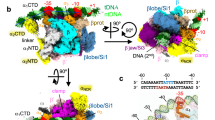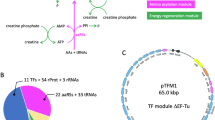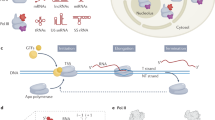Abstract
THE ribosomal cistrons of Escherichia coli comprise only 0.2 to 0.4% of the genome and yet in exponentially growing cultures 40% of the instantaneous rate of RNA synthesis can be ribosomal RNA1,2. These genes are under stringent control, which means that they are not expressed in wild type (rel+) cultures starved for amino-acids3. Travers et al.4,5 postulated that a protein factor, called ψr, is a positive regulator of the rRNA genes, responsible for both their preferential synthesis and their turn-off during amino-acid starvation. This appealing hypothesis rests on their report that purified RNA polymerase synthesizes no detectable rRNA from E. coli DNA. They concluded that addition of ψr (a protein factor found either in crude extracts of uninfected E. coli or as a component of Qβ replicase) to the in vitro reaction specifically stimulates rRNA synthesis so that it accounts for 30% of the transcript. They also reported that ψr does not stimulate rRNA synthesis in the presence of guanosine tetraphosphate (a phosphorylated nucleoside accumulated in stringent cells starved for amino-acids)6,7. Of the in vitro product, 10% is rRNA in the presence or absence of ψr.
This is a preview of subscription content, access via your institution
Access options
Subscribe to this journal
Receive 51 print issues and online access
$199.00 per year
only $3.90 per issue
Buy this article
- Purchase on Springer Link
- Instant access to full article PDF
Prices may be subject to local taxes which are calculated during checkout
Similar content being viewed by others
References
Yanofsky, A. A., and Spiegelman, S., Proc. US Nat. Acad. Sci., 48, 1466 (1962).
Kennell, D., J. Mol. Biol., 34, 85 (1965).
Lazzarini, R. A., and Winslow, R. M., Cold Spring Harbor Symp. Quant. Biol., 35, 383 (1970).
Travers, A. A., Kamen, R. I., and Schleif, R. F., Nature, 228, 748 (1970).
Travers, A. A., Kamen, R. I., and Cashel, M., Cold Spring Harbor Symp. Quant Biol., 35, 415 (1970).
Cashel, M., and Kalbacher, B., J. Biol. Chem., 245, 2309 (1970).
Miura, K., Methods in Enzymology, 12, 543 (1967).
Marmur, J., J. Mol. Biol., 3, 208 (1961).
Burgess, R. R., J. Biol. Chem., 244, 6160 (1969).
Berg, P., Barrett, K., and Chamberlin, M., Methods in Enzymology (in the press).
Pettijohn, D. E., Clarkson, K., Kossman, E. R., and Stonington, O. B., J. Mol. Biol., 52, 281 (1970).
Burgess, R. R., Travers, A. A., Dunn, J., and Bautz, E., Nature, 221, 43 (1968).
Kamen, R. I., Nature, 228, 527 (1970).
Margulies, L., Remeza, V., and Rudner, R., J. Bact., 103, 560 (1970).
Vogt, V. V., Nature, 223, 854 (1969).
Roberts, J. W., Nature, 224, 1168 (1969).
Cashel, M., Cold Spring Harbor Symp. Quant. Biol., 35, 415 (1970).
Gallant, J., Erlich, H., Hall, B., and Laffler, T., Cold Spring Harbor Symp. Quant. Biol., 35, 397 (1970).
Author information
Authors and Affiliations
Rights and permissions
About this article
Cite this article
HASELTINE, W. In vitro Transcription of Escherichia coli Ribosomal RNA Genes. Nature 235, 329–333 (1972). https://doi.org/10.1038/235329a0
Received:
Revised:
Issue Date:
DOI: https://doi.org/10.1038/235329a0
This article is cited by
-
Control of ribosomal RNA synthesis in Escherichia coli
Molecular and General Genetics MGG (1981)
-
In vitro transcription of the ribosomal RNA genes of E. coli DNA
Molecular and General Genetics MGG (1977)
-
Control of ribosomal RNA synthesis in Escherichia coli
Molecular and General Genetics MGG (1977)
-
RNA polymerase specificity and the control of growth
Nature (1976)
-
Modulation of RNA polymerase specificity by ppGpp
Molecular and General Genetics MGG (1976)
Comments
By submitting a comment you agree to abide by our Terms and Community Guidelines. If you find something abusive or that does not comply with our terms or guidelines please flag it as inappropriate.



